Sometimes it is hard to engage users, especially when it comes to learning. The process of learning something is often associated with boredom, dullness, and repetitiveness. To acquire new knowledge or skill, a learner has to be strongly disciplined, patient, and perseverant; and let’s be honest, many lack these qualities.
But what if we turn the learning process into something engaging and fun? What if we make it feel like a game?
That is what gamification in e-Learning is all about. By introducing game elements to your educational app, you will make the learning experience more interactive and exciting while significantly enhancing user retention.
As a company that specializes in e-Learning software development, AnyforSoft wants to elaborate more on the importance of gamification in the e-Learning industry. Keep reading to:
- learn what gamification in e-Learning is;
- see examples of applications that use gamified elements;
- explore the benefits of gamification;
- discover best gamification practices, and more.
Without further ado, let’s get started.
What is gamification in e-Learning?
In simple terms, gamification in online learning is adding game-like elements and gaming mechanics to online learning platforms. These game-based elements include:
- Achievement badges. Achievement badges are virtual rewards that learners receive for completing specific tasks, milestones, or achievements within your learning system. These gaming elements serve as a visual representation of the learner’s progress, motivating them to finish their online course.
- Leadership boards. Introducing leaderboards is a perfect way to gamify e-learning and enhance the learning experience. Leaderboards are game elements that display the rankings of learners based on different metrics (points earned, levels completed, quiz scores, etc.). They introduce healthy competition to your platform, motivating learners to study harder in order to outperform their fellows.
- Points. Points are effective game mechanics that increase student engagement and improve the learning experience. Points are awarded to learners for completing activities, answering questions correctly, or achieving specific goals within the e-learning platform. They offer immediate feedback on performance, helping learners analyze their mistakes and improve.
- Progress indicators. Progress indicators are interactive elements that display the learner’s progress through training programs, courses, and modules. They give the users a sense of achievement, encouraging them to keep going and finish what they’ve started.
- Mini-games. The term “mini-games” is self-explanatory. These interactive activities offer learners a break from traditional e-learning programs while still reinforcing learning objectives. In the “Examples Of Gamification In E-Learning” part, we explain this in more detail.
- Quizzes. Quizzes are assessments presented in the form of questions or exercises that test learners’ understanding of the course material. This gamified e-learning element helps learners better memorize the material by applying their knowledge. Quizzes also provide feedback on comprehension and identify areas for further improvement.
The primary goal behind eLearning gamification is to make the learning journey more interactive, appealing, and engaging, thus increasing user retention rates.
Gamification of e-Learning has nothing to do with creating an entire video game alongside your online courses. As noted above, it is about introducing game mechanics to your application to turn rather boring learning activities into fun and engaging experiences.
For example, by creating leadership boards, you will introduce healthy competition to your e-Learning course. That will motivate learners to study harder in order to outperform their fellows. You can also add awarding badges to provide learners with a sense of achievement and incentivize hard work.
AI-Powered Gamification: What’s Next for E-Learning?
Gamification is evolving, and artificial intelligence is the key driver of its next chapter.
The Singapore’s Institute of Technical Education research highlights just how powerful this combination can be. In a study, AI-enhanced gamification, compared to non-AI approach, led to:
- 18.7% improvement in practical skills
- 44.2% improvement in theoretical understanding of learning materials
Amplified by Machine Learning and Natural Language Processing (NLP) technologies, this approach transforms into a dynamic, data-driven learning strategy tailored to learners’ behavior and performance.
Let’s explore how AI in EdTech transforms gamified learning into personalized, adaptive experiences.
Personalized learning paths
AI analyzes each learner’s behavior, performance trends, and preferences to build tailored learning trajectories. Instead of assigning the same gamified module to everyone, the system adapts content and challenges based on what each employee needs to grow. This ensures relevance and minimizes cognitive overload.
Example: Degreed’s AI engine, Maestro, automatically tailors training pathways and content recommendations based on each person’s role, existing skills, and goals.
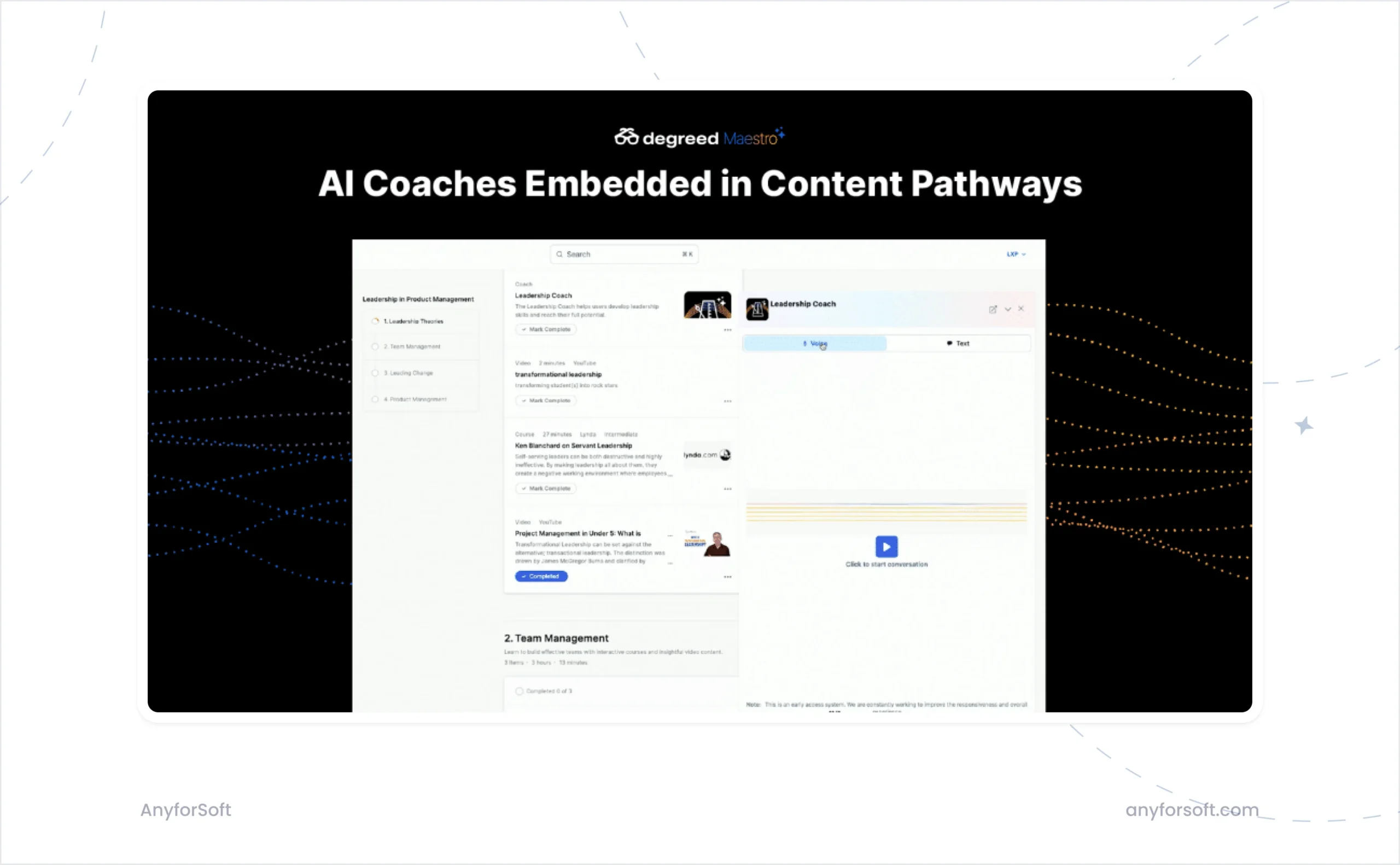
Adaptive difficulty
AI dynamically adjusts the complexity of tasks, quizzes, or simulations in real time. If a learner is struggling, the system may simplify tasks or offer support; if they’re progressing quickly, it introduces greater challenges to maintain engagement.
This keeps learners in their optimal performance zone and helps them build confidence progressively.
Example: Axonify’s AI-powered microlearning system continuously evaluates what each employee knows and where they struggle. If a learner is having trouble with a topic, the platform will present easier questions or offer hints; if the learner is excelling, it will introduce tougher challenges. This dynamic adjustment keeps learners in their optimal performance zone.
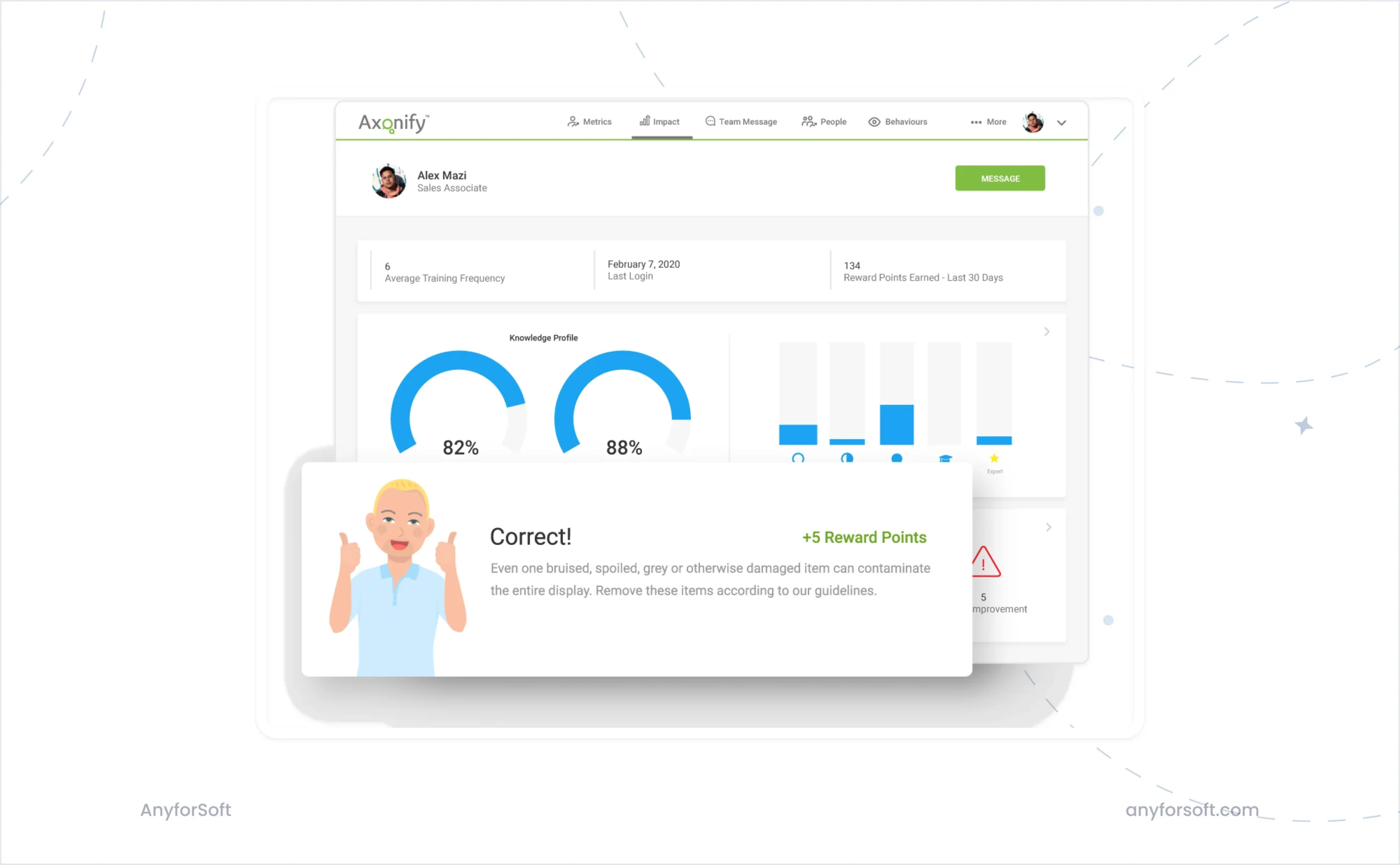
AI-generated content and simulations
AI automatically creates personalized quiz questions, scenario-based exercises, or branching simulations. These elements respond to role-specific training needs or learner progress without requiring constant manual input from instructional designers, saving time while enhancing relevance.
Example: LearnUpon produces scenario-based exercises or branching quiz paths aligned to a learner’s role. As a result, training stays relevant to each learner’s context.

Instant, context-aware feedback
AI provides real-time feedback that reflects not only whether a learner was right or wrong, but also why. By interpreting open-ended responses or task completion patterns, it delivers suggestions and corrections that help learners understand their mistakes and improve faster.
Example: The Edly offers an AI Coach feature: it analyzes a learner’s free-text responses and immediately provides personalized feedback and guidance. For instance, if an employee answers an open-ended scenario incorrectly, the AI might highlight the part of their reasoning that was off and suggest a hint or a resource, helping the learner understand why their answer was wrong.
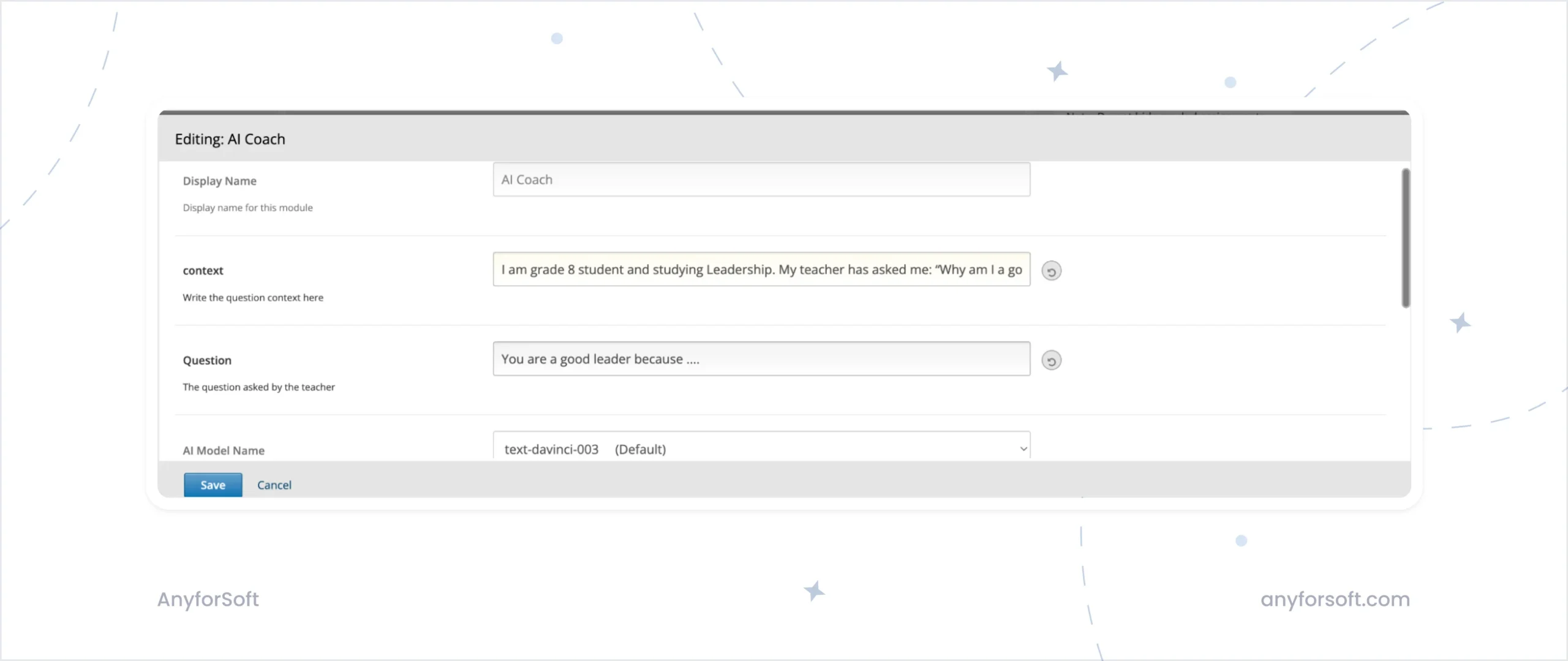
Insightful analytics for continuous improvement
AI doesn’t just enhance the learner experience; it gives organizations the tools to optimize it. Through real-time dashboards and performance analytics, you can see which gamified features increase completion rates, identify where learners struggle or drop off, and track overall engagement levels across teams.
These insights allow for ongoing refinement of your training strategy based on real learner data in contrast to assumptions.
Example: Docebo uses AI to monitor learner behavior, recommend relevant content, and assign skills automatically. These insights help align gamified elements with real learner needs, making rewards more meaningful and engagement more consistent.
Before implementing advanced features like AI-powered gamification, it’s essential to lay a strong foundation by ensuring your platform is stable, secure, and user-friendly.
For example, Delaware County Community College worked with AnyforSoft to improve security and usability across multiple educational websites—critical groundwork for implementing advanced features like AI-powered gamification.
Gamification in Action: How Quizlet, Duolingo, and Codecademy Hook Learners
Badges and leaderboards are easy to talk about. Much harder to implement well.
Here’s how leading apps like Quizlet and Duolingo use gamification to boost retention — and what you can take from their playbooks.
#1 Multiple gamification elements in Quizlet

We’ve mentioned Quizlet before when discussing smart education app design — and for good reason. It’s a standout example of how gamification can make self-paced learning stick.
Instead of passively flipping flashcards, students can race against the clock to match terms with their definitions. Their scores land on a leaderboard, sparking friendly competition and motivating repeat plays (aka: more exposure = better retention).
This game mechanics nudges users to stay engaged, challenge themselves, and reinforce knowledge.
Quizlet also includes:
- Instant feedback. Upon completion of each study set, a student receives instant feedback on how well they performed. The app shows their test score and indicates mistakes (if any). That helps in identifying areas of improvement.
- Achievement badges. Quizlet offers a wide variety of badges. A user can receive an achievement badge for using the application for 3 days in a row. Or they can obtain it for finishing a specific number of study sets.
- Personalized online learning experience. Learners can choose their own way and pace of learning content. They can learn study sets by playing a matching game, memorizing flashcards, or through customized tests.
- Interactive AI-driven practice. Quizlet’s Brain Beats turns flashcards into catchy songs to make memorization more fun, while Q-Chat uses AI to act as a conversational tutor, providing instant, interactive feedback. Together, they make studying feel more like a game and keep learners engaged.
#2 Killer gamification features of Duolingo

With over 300 million users worldwide, Duolingo is arguably the most popular language learning mobile app. Its strength lies in habit formation — using bite-sized lessons, gamified learning elements, and playful challenges to keep learners coming back. Add in a persistent mascot (yes, that owl) and smart AI personalization, and you’ve got a product that makes language learning feel less like homework and more like a daily streak you don’t want to break.
Let’s look at some e-learning gamification techniques the app puts to use.
- Awarding badges. Duolingo uses lots of awarding badges to provide learners with a sense of achievement. You can get one for using the app for three days in a row.
- Experience points. Upon the completion of a lesson or a story, each user is rewarded with experience points (XP). These points are displayed on user profiles and indicate their language level. Learners with the most experience points are featured in Duolingo leagues and leaderboards, which introduces healthy competition to the app.
- Lingots. Lingots are Duolingo’s own in-app currency that can be earned by meeting daily learning goals, leveling up, unlocking achievements, and through other activities. This currency can be spent on new lessons, various power-ups, cute outfits for Duo the owl, and more.
- Birdbrain AI personalization. Duolingo’s machine learning model, Birdbrain, continuously analyzes how much each learner knows and how difficult each exercise is. It then adjusts the difficulty level of lessons in real time, ensuring that learners always receive content that is appropriately challenging. This personalization directly boosts the effectiveness of gamified elements — by helping users maintain streaks, earn XP, and progress through levels without feeling stuck or bored.
#3 Learning coding through gamification with Codecademy
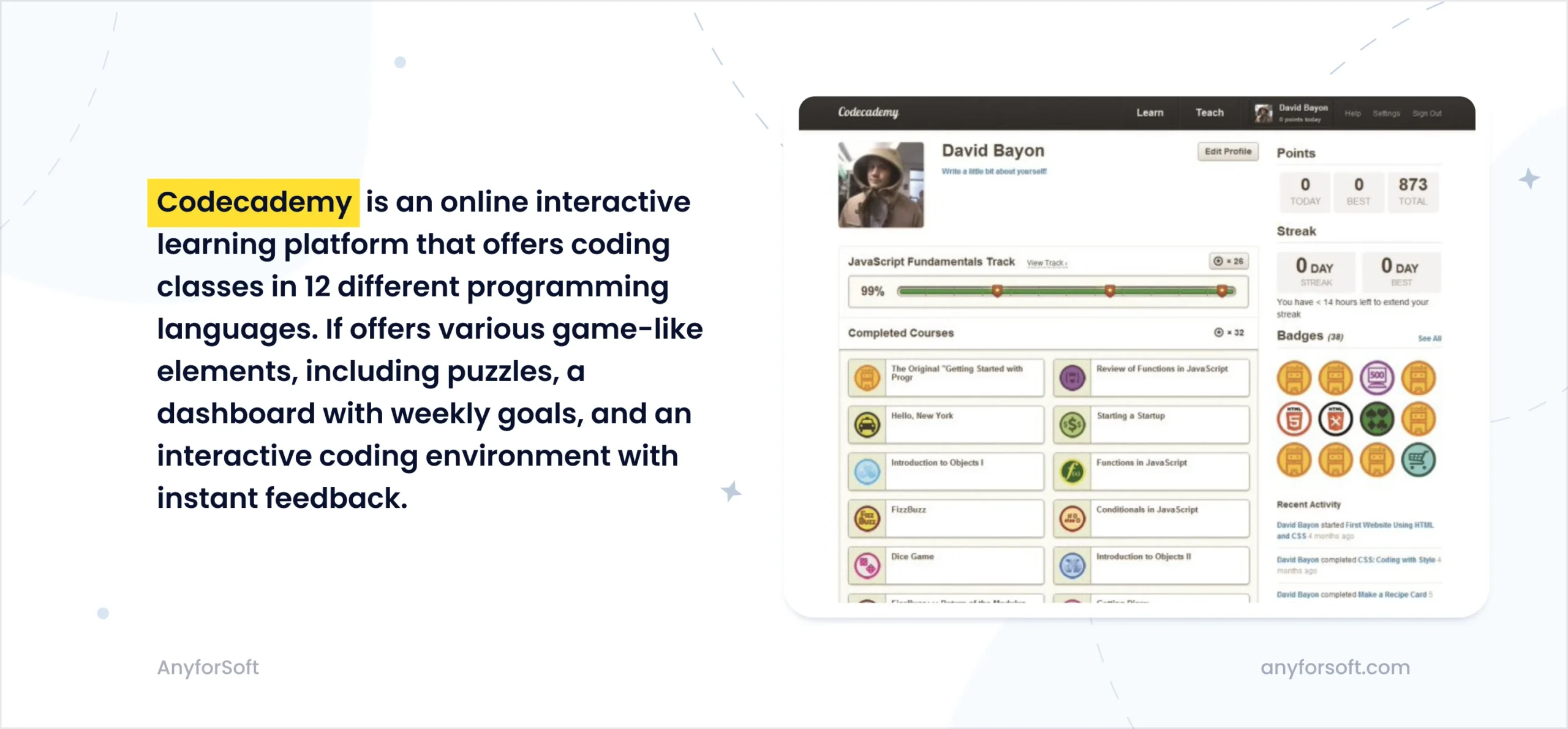
Codecademy shows how gamification can turn something as intimidating as learning to code into a more approachable, even rewarding, experience.
Programming is complex and often demotivating when you hit a wall. But Codecademy breaks that pattern using bite-sized puzzles, instant feedback, and a streak-based learning loop.
The platform teaches 12+ languages (Java, Python, Ruby, and more), wrapped in game mechanics that keep learners moving and make even debugging feel like progress.
- Puzzle games. Codecademy uses puzzle games as a way to simplify the learning of programming languages and improve knowledge retention. By breaking down complex concepts into smaller, bite-sized puzzles, the platform allows learners to grasp these concepts more easily.
- Dashboard with weekly goals. The platform also offers a dashboard where you can set your weekly learning goals and monitor your progress. For example, if you want to study 5 days a week, Codecademy will help you track how well you are performing in that regard.
- Interactive coding environment with instant feedback. The coding environment on Codecademy is divided into three sections: a theory panel for key concepts, a code editor for hands-on practice, and a live output window that shows results in real time. This setup gives learners immediate feedback — helping them test ideas, catch mistakes, and build confidence with every step.
- AI-powered learning assistant and project hints. Beyond basic real-time feedback, Codecademy’s AI Learning Assistant provides personalized, context-aware guidance during coding challenges. It analyzes learners’ code, offers targeted hints to help them get unstuck without giving away full solutions. This dynamic support enhances the gamified experience, keeping learners motivated and boosting confidence as they tackle increasingly complex tasks.
Benefits of Gamification in E-Learning: Why Even Bother?
If you’re still relying on “chalk and talk” in 2025, you’re not just behind — you’re burning potential learning gains.
See what advantages gamification adds to e-learning?
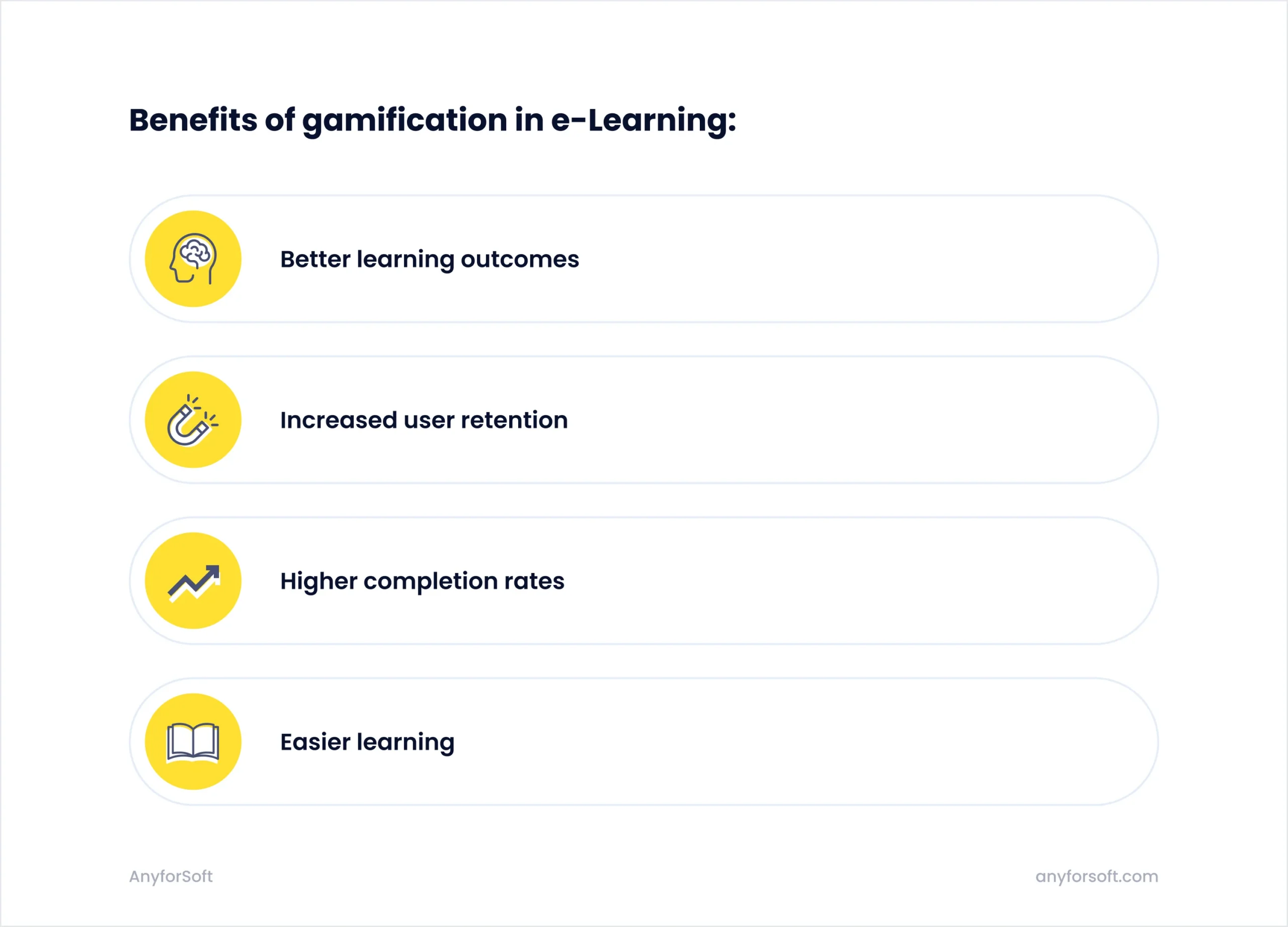
Better learning outcomes
Studies consistently show that game-based learning (GBL) leads to stronger outcomes compared to traditional methods. A 2023 study by the National Library of Medicine found that GBL not only improved academic performance in math, but also boosted student motivation and positive attitudes toward learning.
With the right mechanics in place, gamification can do more than just entertain. It can improve knowledge retention, encourage progress, and drive real results in everything from corporate training to higher ed.
Increased user retention
Gamified e-learning boosts engagement and keeps users coming back. By adding game mechanics like progress tracking, challenges, or interactive rewards, platforms can increase stickiness and reduce dropout rates, even among learners who typically struggle with motivation.
Take our work with a SaaS client in higher ed: AnyforSoft helped them design an interactive virtual campus tour that incorporated gamified elements like checkpoints, student avatars, and milestone badges. Eventually, students spent more time exploring the platform and were more likely to return to campus, even before enrolling.
Higher completion rates
A gamified course has a higher chance of being fully completed. Thanks to leadership boards, progress indicators, and various other features, apps that use gamification for e-learning give users an idea of how far they’ve come in their learning path. That’s critical because when a learner sees what progress they’ve already achieved, this motivates them to keep going. Thus, they’re less likely to abandon their education. No wonder gamification is so heavily used in employee training.
Easier learning
In the example of Codecadamy, we’ve seen how even complex subjects such as coding can be made easier with gamified e-learning. By introducing game-like features and gamified assessments to your educational app, you will make the learning process less intimidating and more fun. This will help you broaden and diversify your audience, resulting in higher income.
Gamified learning environments lead to 14% higher success rate and a 17% higher average grade versus traditional methods.
— Impact of Gamification on Students’ Learning Outcomes and Academic Performance, Mendeley Journal, 2024
How to Use Gamification in E-Learning: Best Practices
Now that you’ve learned what game-based learning is and seen prominent examples of gamification in e-learning, let’s talk about how to apply the gamification approach in your learning environment.
Rule #1: Don’t add gamification just for the sake of it
Don’t introduce gamification elements because your competitors are doing it. Add them to improve the learning experience and actually help learners achieve progress. That said, your gamification strategy should be perfectly aligned with the learning objectives, with every element contributing to the learning outcomes.
Rule #2: Be transparent on criteria and progression
Your learners should know how gamified content works in order to stay engaged and motivated. Make sure that your educational games are well-explained: users should know for what they get their points, how these points translate into achievement badges, what criteria they should meet to receive a new award/unlock a new level, and so on. If the rules aren’t clear, don’t expect learners to play along.
Rule #3: Increase the difficulty gradually
People love challenges, but if you make game-based learning too difficult right from the start, you will discourage them. That’s why we recommend increasing the difficulty gradually. Start with something easy—let your learners collect some awards and achievement badges without much effort. Once they get a taste for it, make the game more challenging to keep them interested and engaged.
Rule #4: Allow social interaction
Why achieve something when you can’t share it with others, right? Every major e-learning platform understands the need of learners to share their achievements so they incorporate social interaction functionality. We advise you to do the same. Enable learners to share their achievements on social media—not only will this motivate them to study harder, but it will also help you promote your platform for free.
Rule #5: Ensure personalization
Personalization of learning and gamification is critical for your platform’s success. Obviously, each learner is different, and if you manage to tailor the learning experience for every user’s learning needs, you will help them study more effectively. So make sure to use adaptive difficulty levels, personalized learning paths, customized feedback based on learner performance, and other personalization strategies.
Rule #6: Facilitate continuous learning
Find ways to encourage learners to keep returning and improving their scores. You can do that by regularly resetting leaderboards, introducing new challenges or rewards, using push notifications, and so on. Give learners a reason to keep coming back for more rather than considering their learning “done.” If you do that right, your audience engagement and retention will increase dramatically.
Rule #7: Keep accessibility and inclusivity in mind
When designing gamified e-learning courses, don’t forget about accessibility and inclusivity. You should take into account diverse learning styles, disabilities, and cultural backgrounds to ensure that all learners have equal opportunities to participate and succeed. That way, you will enhance the learner experience and will be able to target a wider audience, which will eventually translate into more income for your business.
Rule #8: Provide immediate feedback
Gamification in corporate training and other learning activities should always come with some form of feedback. Therefore, you should always offer immediate and constructive feedback to learners as they engage with educational content. This feedback loop can come in various forms, such as points, badges, or visual cues, and should help learners understand their progress, learning processes, and areas for improvement.
Rule #9: Include visual aids
Gamification in the educational context should leverage appealing design and aesthetic elements to draw learners into participating in the game. One of the easiest ways to make learning fun is by adding visual aids. This includes visual hooks, typographic elements, user-friendly navigation, visual pointers, and so on. By introducing these elements, you will make your platform more visually appealing while making sure no one gets lost when exploring it.
Rule #10. Define AI use cases and scale smartly
Clearly identify where it will genuinely improve learning outcomes and remain cost-efficient. Start small, gather real user feedback, and fine-tune your approach before full rollout.
For example, an AI chatbot can support gamification by giving learners tailored hints, real-time guidance, and encouraging prompts, making the experience more interactive and engaging.
Rule #11: Build a strong foundation first
Before implementing gamified or AI-powered features, make sure your platform has a robust technical foundation. Optimizing performance, improving user experience, and ensuring scalable architecture are crucial steps that prevent future rework and support the success of new features.
For example, Imperial College Business School partnered with AnyforSoft to streamline performance and enhance the user experience through thoughtful updates and custom modules. This created a solid base before introducing more advanced functionality like gamification.
Conclusion: How to Gamify Your Platform?
Is it time to start or not? The simplest way to find out is to look at your competitors. Do they already use these features? If so, chances are high they’re already gaining the benefits, and by putting off implementation, you risk falling behind.
In terms of metrics, the following are strong reasons to begin gamifying your platform:
- Your platform has low student retention or poor learner engagement rates.
- Course completion rates are dropping, and learners aren’t coming back.
- Poor knowledge retention in assessments.
Once you’ve assessed your needs and decided to move forward, the next step is finding the right partner to help you bring your vision to life.
AnyforSoft has more than 12 years of experience in E-learning platform development, including projects in LMS gamification, and we’re glad to put our expertise to work for your goals.
To start with AnyforSoft, you don’t need a fully formed solution. You can come with a broad idea, a list of feature wishes, or even sketches—and our team will help turn that into a practical, effective gamification strategy.
We’ll provide clear recommendations on outcomes, development steps, timelines, and budgets, so you can move forward confidently.
FAQs
Almost any type of online learning platform or E-learning application can be gamified to improve engagement and learning outcomes. Examples include:
- Learning Management Systems for formal education
- Enterprise Learning Management Systems
- Learning Experience Platforms (LXP) focused on personalized learning journeys
- Student portals for higher education or K-12 institutions
- Course marketplaces
- Employee onboarding and training portals
- Microlearning or mobile-first learning apps
- Certification and compliance training platforms
At AnyforSoft, we can implement gamification features into any platform, fully tailored to your needs.
Absolutely! You can design and implement custom gamification features tailored to your specific goals, audience, and learning context. In many cases, new features will be an extended version of one of the best practices, which is a plus because their value is backed by user success.
Here are some examples of features, extended by AI in particular:
- AI-powered adaptive challenges—tasks and activities that automatically adjust their difficulty or content based on each learner’s performance and engagement levels.
- Personalized quest paths—unique learning journeys with milestones and rewards customized to each learner’s goals, roles, or interests.
- Intelligent hint systems—AI-driven guidance that offers contextual hints or nudges without revealing answers, keeping learners motivated and self-directed.
- Dynamic leaderboard variations—leaderboards that highlight different metrics (e.g., consistency, improvement rate) rather than just total points, to engage diverse learner types.
- Virtual mentors or AI coaches—chatbot-like features that guide learners through challenges, provide feedback, and celebrate achievements in real time.
Custom gamification features can also be developed as needed to round out your e-learning solution and create a more complete, immersive learning experience, especially when combined with advanced AI solutions for education.
You need three things, starting with the most important:
- A clear understanding of your goals—which points of your platform’s efficiency would you like to improve? Higher retention, more personalized learning paths, increased course completion?
- Proprietary data—essential if you want to build an AI tutor capable of handling complex tasks, such as providing context-aware hints, analyzing open-ended responses, or guiding learners through adaptive, scenario-based challenges.
- A technical team—to ensure seamless integration and continuous supervision of new features based on performance outputs and user feedback.
AnyforSoft has experience integrating AI into platforms across different industries as part of our chatbot development services. We also have deep expertise in fine-tuning LLMs to create highly accurate and helpful chatbot assistance.
With this expertise, we can help you build an AI-powered solution tailored specifically for EdTech, from personalized gamification features to advanced learner support tools that allow learners to stay engaged and motivated.
Absolutely! In fact, starting small is often the smartest approach. You can begin by adding simple features like points, badges, or progress indicators to gauge how your learners respond and what impact these elements have on engagement and retention.
Once you see positive results and gather feedback, you can gradually introduce more advanced elements, such as adaptive challenges, leaderboards, or AI-powered personalization. This phased approach allows you to minimize risks, control costs, and ensure each new feature truly supports your goals while building toward a fully immersive learning experience.
At AnyforSoft, we can help you design a step-by-step gamification roadmap, so you can scale confidently based on real outcomes.
It’s impossible to provide you with a truthful range of figures, not to mention to offer an exact estimation. Only approximate estimations make sense since every project has its own complexity and scope of work. However, to help you get a general idea, we can outline three typical ranges:
- Minimum Viable Product (MVP): $30,000–$60,000. An MVP focuses on core features only, for example, adding basic points, badges, and progress indicators to test initial user reactions. This option helps validate the concept quickly and cost-efficiently before scaling further.
- Full-featured project: $60,000–$150,000. A more comprehensive solution that includes additional elements like leaderboards, mini-games, advanced analytics, and personalized learning paths. This type of project focuses on fully engaging your audience and creating a robust gamified experience across your platform.
- Advanced project with AI-powered features: $150,000 and up. This includes sophisticated capabilities such as adaptive difficulty, AI-generated challenges, real-time personalized feedback, and intelligent chatbots. These features transform a platform into a highly dynamic and data-driven learning environment tailored to each learner.
No matter which direction you choose, at AnyforSoft we provide clear recommendations on scope, development steps, timelines, and budgets so you can plan confidently and avoid unexpected costs.
Just like with cost, only generalized estimations are possible since the timeline depends heavily on your platform’s complexity, the feature set, and the level of customization. However, here’s a rough breakdown to help you plan:
- Minimum Viable Product (MVP): 2–4 months. This includes building and integrating core features such as points, badges, and simple progress indicators — enough to test the concept and gather initial user feedback quickly.
- Full-featured project: 4–8 months. A more comprehensive solution involving leaderboards, mini-games, advanced analytics, and more extensive personalization. This stage focuses on creating a fully engaging and polished gamified experience.
- Advanced project with AI-powered features: 8–12+ months. When incorporating AI-based personalization, adaptive challenges, real-time feedback, and intelligent chatbots, the timeline extends to allow for data preparation, model integration, iterative testing, and fine-tuning.
At AnyforSoft, we guide you through every step of the process and help create a realistic, predictable roadmap so you know what to expect and when to expect it.








